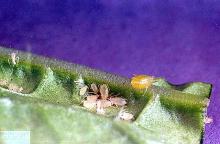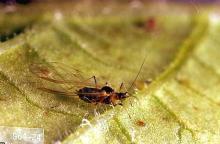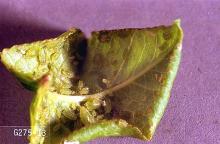Includes
Green peach aphid (Myzus persicae)
Willow-carrot aphid (Cavariella aegopodii)
Pest description and crop damage The wingless form of the green peach aphid is yellowish green in color. The winged form has a black head and thorax, and a pale green abdomen marked with dark bands on the top and sides with a distinct dark patch on the top. The wingless form of the willow-carrot aphid is pale green and oval-shaped. Green peach aphids and willow-carrot aphids are vectors of several important virus diseases in carrots.
Scouting and thresholds No treatment threshold has been determined for aphids on carrots grown for seed. Growers should inspect plant foliage and umbels for aphid activity. Also, look for evidence of predators. Treatment may be warranted if aphid populations increase drastically over time or if virus diseases vectored by aphids are of concern.
Management-chemical control
- acephate (Acephate 97UP, Orthene 97) at 1 lb/A (1.03 lb ai/A). REI 24 hr. Use of a buffering agent and anti-drift agent is suggested. This product is highly toxic to bees exposed to direct treatment on blooming crops or weeds. Do not apply to blooming carrot seed crops during the pollination period. Do not spray if there is another seed field within half a mile that is being pollinated. Allow a minimum of 7 days between applications. Do not apply more than 2 lb/A (2.06 lb ai/A) per crop year. Do not apply through any type of irrigation system. No portion of treated plants can be used for food or feed. 24c SLNs: Orthene 97 OR-090025 (expires 12/31/25). Oregon only.
- bifenthrin (Bifenture EC) at 3.9 to 6.4 fl oz/A (0.06 to 0.1 lb ai/A). REI 12 hr. Do not make applications more than 21 days apart. This product is highly toxic to bees exposed to direct treatment or residues on blooming crops or weeds. Use prebloom (allow 5 days before introducing pollinators) or after pollination. Do not exceed two or three applications per crop year (restrictions vary with each 24c SLN label). There are some restrictions pertaining to rotation crops. Extremely toxic to fish and aquatic invertebrates, so follow buffer zone restrictions on the label. Do not apply through chemigation. No portion of treated plants can be used for food or feed. 24c SLNs: WA-070014 (expires 12/31/27) Washington only. See the Carrot section for more allowed bifenthrin products.
See also:





